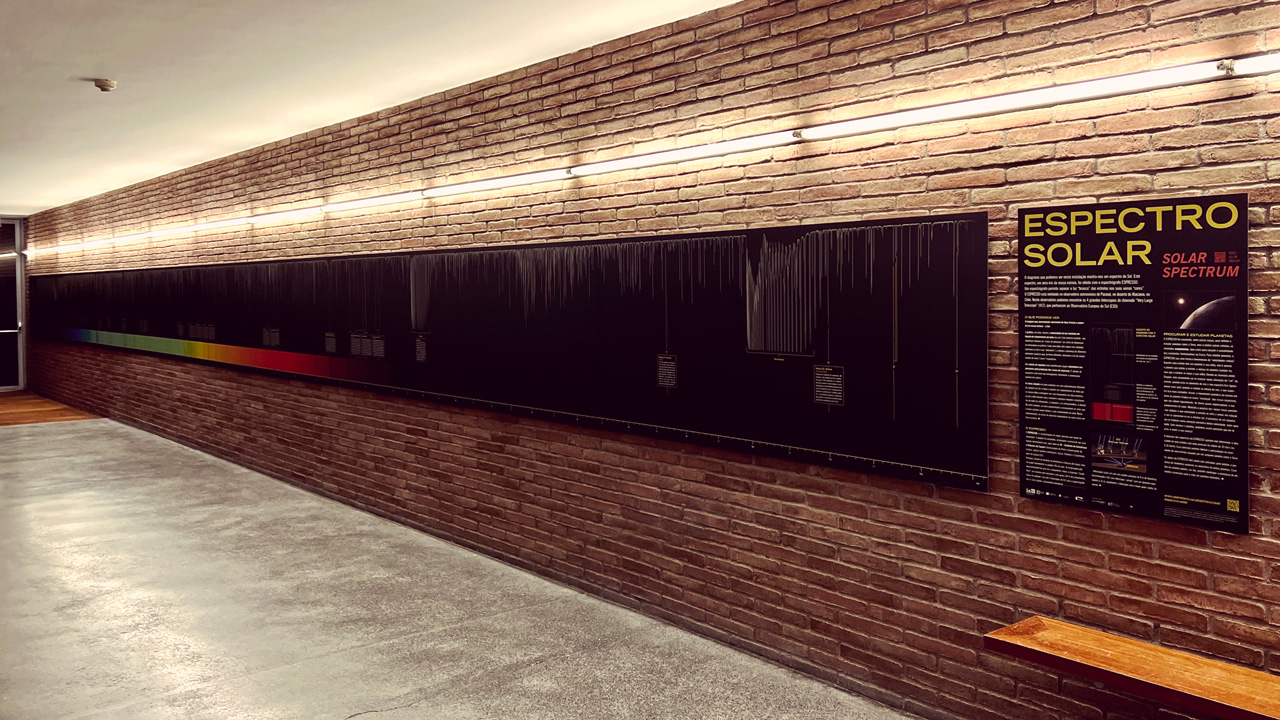Solar spectrum
The diagram we can see in this installation shows us a spectrum of the Sun. This spectrum, a rainbow of our star, was obtained with the ESPRESSO spectrograph. A spectrograph allows the 'white' light from stars to be separated into its various 'colours'. ESPRESSO is installed at the Paranal astronomical observatory in Chile's Atacama Desert. This observatory houses 4 big telescopes of the European Southern Observatory’s (ESO) Very Large Telescope (VLT).
WHAT WE CAN SEE
This image shows two different ways to represent the spectrum of our star – the Sun.
The graph above shows the intensity of the light received as a function of wavelength (or colour). This spectrum allows us to identify thousands of 'absorption lines' (the areas of decreasing intensity on the graph). Each one comes from the outer layers of the Sun (its 'atmosphere'), and denotes the presence of different chemical elements that absorb light of specific wavelengths ('colours') in different ways.
Some of the elements responsible for producing the absorption lines are identified in the caption boxes. It is through these types of spectra that we can determine the chemical composition of the stars.
In the band at the bottom we can see a different representation of the solar spectrum: the band is coloured in the wavelengths that our eyes can see, but disappears at both ends, as the human eye is not sensitive to radiation in those wavelengths ( ultraviolet, on the left and infrared, on the right). In the coloured part, the colours correspond to those that our visual system assigns to each wavelength. In this representation, the absorption lines appear as dark vertical lines.
THE ESPRESSO
ESPRESSO is the most accurate spectrograph available today. The project was conceived, designed and built by an international team that, besides the IA – Institute of Astrophysics and Space Sciences (University of Porto and University of Lisbon), also included Swiss, Italian and Spanish institutions, besides ESO itself.
Portugal, through the Institute of Astrophysics and Space Sciences, had a key role in the project. On one hand, it was responsible for the development of one of the key components: the so-called "Coudé Train", an opto-mechanical system, almost 100 m in length, capable of steering the light from the 4 VLT telescopes to the spectrograph itself. This system, entirely designed and built in Portugal (and with the participation of national industry), allows the light from the 4 telescopes (each with an 8 m diameter main mirror) to be combined, turning the VLT into a "virtual" telescope with an equivalent diameter of 16 m, currently the telescope with the largest collecting power in the world.
SEARCHING AND STUDYING PLANETS
ESPRESSO was designed, among other things, to detect and study Earth-like planets orbiting other stars, the so-called exoplanets, as well as to study the variability of the fundamental constants of physics. To detect planets, ESPRESSO uses a technique called "radial velocity". When a star has a planet around it, it is not only the planet that orbits the star: the mass of the planet also causes the star to move around it. Because of the so-called Doppler effect, this motion will result in a change of the star's "colour": when the star is moving towards us its spectrum turns slightly bluer; when the star is moving away from us its spectrum turns redder. Thus, the periodic motion of the star around the planet translates into an 'oscillation' of the spectral lines, which will, almost imperceptibly, shift their wavelength. Measuring the shift of the various lines allows us to deduce how fast the star is moving relative to us (moving closer or further away). The presence of a planet will result in a periodic variation of this speed, night after night. Without seeing the planet, we can thus deduce that it is there, and measure its mass!
The precision of ESPRESSO spectra allows us to determine the speed of a star with an accuracy of about 10 cm/s (or 0.36 km/h). This precision is high enough to detect the perturbation caused by a small planet like the Earth, in its star's motion.
ESPRESSO data have also been used to detect the presence of chemical elements in the atmosphere of other planets. Some day, this type of study may make it possible to investigate the existence of elements essential for life on distant planets.

—
✺ CONTRIBUTIONS Nuno Cardoso Santos, Gabriella Gilli, Sérgio Sousa, Elisa Delgado-Mena, Elsa Moreira, Filipe Pires,
Mário João Monteiro, Paulo Pereira, Ricardo Cardoso Reis, Tiago Campante, Tomás Azevedo Silva and Vardan Adibekyan
✺ INFOGRAPHIC DESIGN PROJECT Paulo Pereira @ IA and Planetário do Porto CCV
✺ Porto, Portugal, 2023

 Rua das Estrelas, 4150-762 Porto
Rua das Estrelas, 4150-762 Porto
T. +351 226 089 800 (chamada para a rede fixa nacional)
geral@planetario.up.pt
Mapa e como chegar





